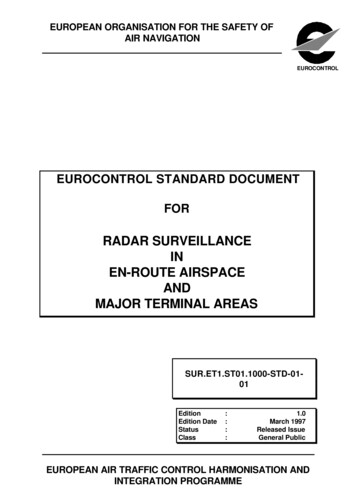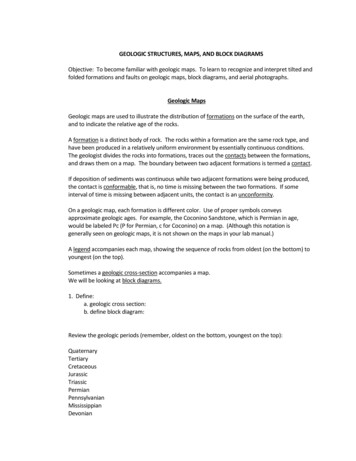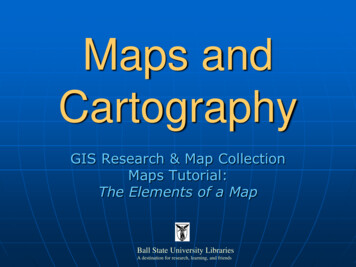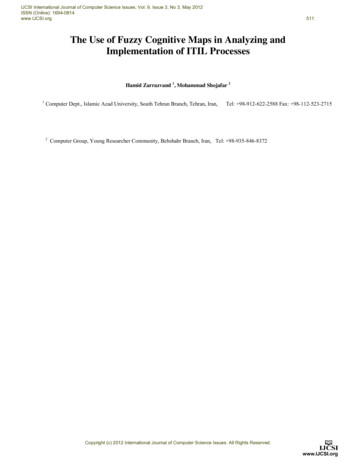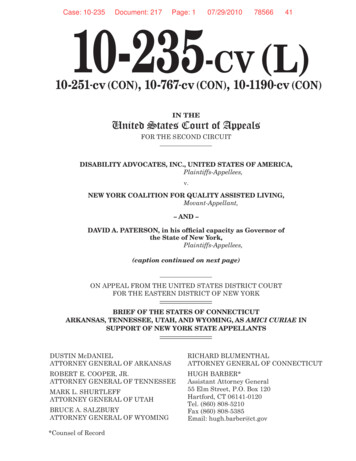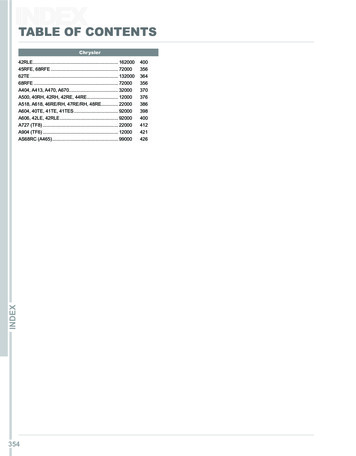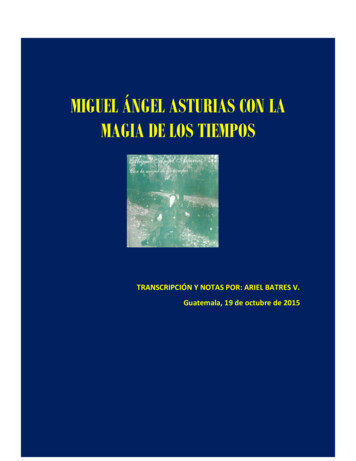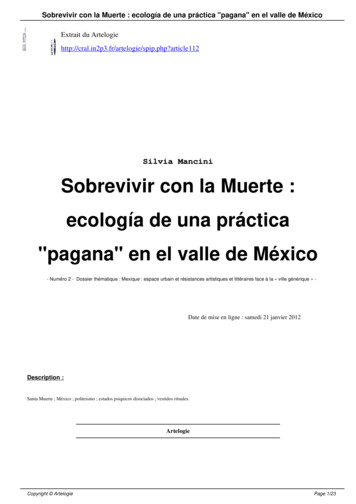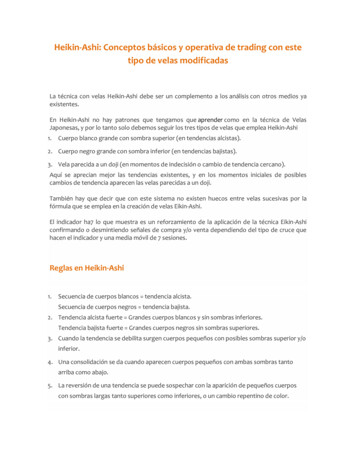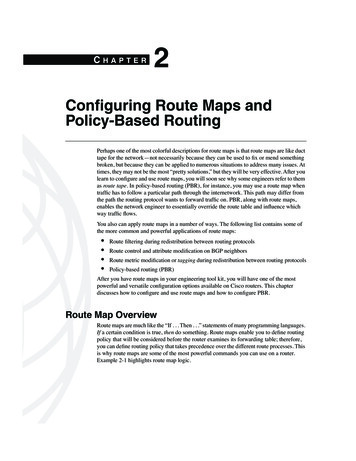
Transcription
CCIE.book Page 147 Friday, October 10, 2003 9:49 AMCHAPTER2Configuring Route Maps andPolicy-Based RoutingPerhaps one of the most colorful descriptions for route maps is that route maps are like ducttape for the network—not necessarily because they can be used to fix or mend somethingbroken, but because they can be applied to numerous situations to address many issues. Attimes, they may not be the most “pretty solutions,” but they will be very effective. After youlearn to configure and use route maps, you will soon see why some engineers refer to themas route tape. In policy-based routing (PBR), for instance, you may use a route map whentraffic has to follow a particular path through the internetwork. This path may differ fromthe path the routing protocol wants to forward traffic on. PBR, along with route maps,enables the network engineer to essentially override the route table and influence whichway traffic flows.You also can apply route maps in a number of ways. The following list contains some ofthe more common and powerful applications of route maps: Route filtering during redistribution between routing protocolsRoute control and attribute modification on BGP neighborsRoute metric modification or tagging during redistribution between routing protocolsPolicy-based routing (PBR)After you have route maps in your engineering tool kit, you will have one of the mostpowerful and versatile configuration options available on Cisco routers. This chapterdiscusses how to configure and use route maps and how to configure PBR.Route Map OverviewRoute maps are much like the “If . . . Then . . .” statements of many programming languages.If a certain condition is true, then do something. Route maps enable you to define routingpolicy that will be considered before the router examines its forwarding table; therefore,you can define routing policy that takes precedence over the different route processes. Thisis why route maps are some of the most powerful commands you can use on a router.Example 2-1 highlights route map logic.
CCIE.book Page 148 Friday, October 10, 2003 9:49 AM148Chapter 2: Configuring Route Maps and Policy-Based RoutingExample 2-1 Route Map Logicroute-map route map name permit 10match criteria 1set perform action 1route-map route-map name permit 20match criteria 2set perform action 2set perform action 3route-map route-map name permit 30match criteria 3 criteria 4 criteria 5set perform action 2set perform action 4set perform action 5route-map route-map name deny 65536match everything implicit deny at the endIn a nutshell, route maps work in the following manner:1 Essentially, a process—whether it is a redistribution process, policy routing, or some otherprocess such as Network Address Translation (NAT)—calls a route map by a text-basedname.2 The route map, in turn, has conditions or match statements, which are usually, but notalways, an access list or extended access list. Border Gateway Protocol (BGP), forinstance, can match on an autonomous system number (ASN) or different attributes.The match statement(s) can be followed by set statements.If the match statement returns a true result, the set statement(s) are executed.Example 2-2 shows how a route map functions during redistribution.Example 2-2 Route Map Function During Redistributionrouter ospf 2001 Call the route-mapredistribute eigrp 65001 subnets route-map route map name and send EIGRP routes for comparison! Route-map with the lowest sequence numberroute-map route map name permit 10gets executed first Call access-list, the IF of the route-mapmatch ip address access list If access-list is true, THEN do somethingset condition! Next highest sequence numberroute-map route map name permit 20gets executed Call access-list, the IF of the route-mapmatch ip address access list If access-list is true, THEN do somethingset condition! Implicit deny at the end all route-mapsroute-map route map name deny 65536This will not show up in the configmatch ip address all routes
CCIE.book Page 149 Friday, October 10, 2003 9:49 AMRoute Map Overview149The next example is the syntax of an actual route map. Example 2-3 demonstrates how a routemap can be applied during redistribution.Example 2-3 Route Map Application During Redistributionrouter ospf ribute eigrp 65001 subnets route-map set tag Call the route-map "set tag"network 10.10.3.0 0.0.0.255 area 0default-metric 10!access-list 10 permit 172.16.32.0 0.0.0.255 Match the 172.16.32.0/24 subnetaccess-list 11 permit 172.16.1.0 0.0.0.255 Match the 172.16.1.0/24 subnet!route-map set tag permit 100 Route-map "set tag"match ip address 10 Call access-list 10, if this is true then set tag 10 If access-list is true set the tag of 10!route-map set tag permit 200 If no match above, try and match the following:match ip address 11 access list 11set metric-type type-1 If the ACL is true, set the OSPF metric type to 1set tag 11 and set a tag of 11!route-map set tag permit 300set tag 300 All other routes get a tag of 300!In the preceding example, a route map is used to control and tag the routes from EnhancedInterior Gateway Routing Protocol (EIGRP) when they are redistributed into Open ShortestPath First (OSPF). During the OSPF redistribution process, a route map titled set tag is called.The route map consists of three parts. The first part calls access control list (ACL) 10, whichwill permit the network 172.16.32.x and set a tag of 10. The second part calls ACL 11, whichin turn matches IP address 172.16.1.x. If a match occurs, the metric will be set such that whenthe route is redistributed, it becomes an OSPF type 1 route; finally, the tag will be set to 11. Thelast part of the route map doesn’t call an ACL, so all routes are matched, and the set conditionis applied. In this example, the router is setting the tag to 300. You can set tags in this mannerto help document the network, or you can use the tags to identify routes that you may want tofilter or perform some other action on.Route maps have the following common characteristics: Route maps are executed in the order of the lowest sequence number to the highest. Youcan edit or modify maps by using the sequence number. If a match is found within a route map instance, execution of further route map instancesstops.
CCIE.book Page 150 Friday, October 10, 2003 9:49 AM150Chapter 2: Configuring Route Maps and Policy-Based Routing You can use route maps to permit or deny the information found true by the matchstatements. If multiple match statements are called within a single route map instance, all matchstatements must match for the route map instance to yield a true result. If route maps are applied in a policy-routing environment, packets that do not meet thematch criteria are then forwarded according to the route table. If there is no match statement in the route map instance, all routes and packets arematched. The set statement will apply to all routes or packets. If there is not a corresponding ACL to the match statement in the route map instance, allroutes are matched. The set statement, in turn, applies to all routes. As with ACLs, an implicit deny is included at the end of the route map policy.You can use route maps to create policies based on the following:— IP address— End-system ID— Application— Protocol— Packet sizeConfiguring Route MapsThe route map syntax is composed of roughly three separate Cisco commands, depending onwhat the route map is accomplishing and what type of process is calling it. This discussioncovers the following commands in detail as route maps are configured throughout this chapter: route-map commandsmatch commandsset commandsWhen configuring route maps, you can follow a basic five-step configuration process.Depending on the route map application, additional configuration may be needed, such as withBGP communities or PBR.Step 1 (Optional) Configure any ACLs, AS PATH list, or any other match criteriathat the route map may be using on the match commands. This should bedone first, so you do not call an empty ACL or AS-PATH list.Step 2 Configure the route map instance. This is accomplished with the route-mapname permit deny sequence number command. Be sure to leave room inbetween the sequence numbers for future updates or modifications. The routemap instance with the lowest sequence number is executed first.
CCIE.book Page 151 Friday, October 10, 2003 9:49 AMRoute Map Overview151Step 3 Define the match criteria and configure the match statements that will beused in this single route map instance. You do this with the route mapconfiguration match command. In the absence of any match commands, allpackets or routes are matched.Step 4 (Optional) Define the set criteria and configure the set statements that will beused in this single route map instance. You can do so with the route mapconfiguration set command.Step 5 (Optional) Configure any ACLs, AS PATH list, or any other match criteriathat the route map may be using on the match commands.Step 6 Apply the route map. Once again, depending on the route map application, itcan be applied in many ways. Some of the more common applicationsinclude route redistribution, PBR, and BGP.With this configuration process in mind, we will discuss in more detail the three primarycommands used to configure route maps.route-map CommandsThe complete syntax for the route-map command is as follows:route-map route map name [permit deny][sequence number 1-65535]The route map name, also called the map tag, is the text-based name of the route map. Thename is unique and logically groups and defines the entire route map policy. This is the namethat you use to call the route map during redistribution and other processes.The permit and deny keywords are optional; the default keyword is permit. If the route mapis called from a redistribution process, the keyword is set to permit, and the match criteria aremet for the route map, the route(s) are redistributed. If the keyword were set to deny, in the samescenario the route(s) would be denied.If the route map is called from a policy-routing statement, the match criteria are met for theroute map, and the keyword is set to permit, the packet would be policy routed. Once again,permit is the default keyword. If the deny keyword is used, the packet is forwarded accordingto the normal route process.The sequence-number indicates in what order the route map statements will be executed. Whena route map is called, the route map with the lowest sequence number is executed first. If amatch is not found in the route map with the lowest sequence number, the route map with thenext highest sequence number is executed. This process repeats itself until a match is found orno more route map statements exist. If a match is found, execution for that individual packet orroute stops, and the next packet or route begins the process again starting with the route-mapstatement with the lowest sequence number. The default sequence number is 10.
CCIE.book Page 152 Friday, October 10, 2003 9:49 AM152Chapter 2: Configuring Route Maps and Policy-Based RoutingNOTEWhen creating route maps, leave room in between sequence numbers for future editing. Beginyour first route map with a sequence of 10 or 100, depending on how big you expect the routemap to be. By using increments of 10 or 100, you leave room for 65 to 650 route map instances.Starting at a higher sequence number and leaving space in between your sequence numbers willmake editing your route maps easier. The maximum route map instance is 65,535.match CommandsThe match commands enable you to define the criteria of the route map. For instance, you canuse the match command to call an ACL to compare routes against. The match statement couldalso match a route tag, a route type, or the length of a packet. BGP offers many exclusive matchstatements that are discussed in Chapters 4 and 5. Table 2-1 lists the match parameters availablein Cisco IOS Software Release 12.2.Table 2-1match Commands in Cisco IOS Software 12.2What It Matchesas-pathBGP AS PATH listclnsCLNS* informationcommunityBGP community listextcommunityBGP/VPN** extended community listinterfaceFirst-hop interface of a routeipIP-specific informationlengthPacket lengthmetricRoute metricroute-typeRoute typetagRoute tag*CommandCLNS Connectionless Network Service** VPN virtual private networkThe match ip address command is by far the most commonly used of the match commands.The match ip address command enables you to call a standard, extended, or expanded-rangeACL. You can use it during redistribution, with BGP, NAT, and during policy routing, as wellas for other functions. The syntax for this match command is as follows:match ip {address [access list prefix-list] next-hop [access list] route-source[access list prefix-list]}
CCIE.book Page 153 Friday, October 10, 2003 9:49 AMRoute Map Overview153In IP networks, this command enables you to match routes that have a network addressmatching one or more in the specified ACL or prefix list. You can use a standard, extended, orexpanded-range ACL.The next-hop keyword enables you to match routes that have a next-hop address matching oneor more in the specified ACL. This is primarily used in BGP.The route-source keyword enables you to match the advertising router’s IP address of theroute/network. You can use a standard, extended, or expanded-range ACL. For BGP, you mayalso use a prefix list.NOTEWhen using the match ip address command in BGP, you can use route maps only to filteroutbound updates. The use of a match ip address route map is not supported on inbound BGPupdates.The next-hop keyword is used primarily in BGP, but it can also be used when redistributingroutes based on the next-hop IP address that correlates to the route. In this case, the router willexamine the NEXT HOP attribute for this comparison.The route-source keyword enables you to match a router’s advertising IP address. If you viewthe IP route table, and route 172.16.3.0/24 is advertised from the IP address of 172.16.2.1, forinstance, the route-source keyword is used to match the advertising router’s IP address of172.16.2.1. In the next sections, these commands are applied to practical examples to show youhow they function.Practical Example: Matching the Route Source and IP AddressIn this model, four routers on a common LAN segment are running two routing protocols. Therouters earp and holliday are running EIGRP as the routing protocol, and the routers ringo andclanton are running OSPF. The router ringo is functioning as an OSPF autonomous systemboundary router (ASBR) by redistributing between EIGRP and OSPF. The ringo router isreceiving several routes from the earp and holliday routers, as depicted in Figure 2-1.In this practical example, a route map is applied during the redistribution of EIGRP into OSPFon the ringo router. The route map named set tag3 is called on the redistribution process forOSPF on the ringo router. The first route map instance, route-map set tag3 permit 100, willperform a match on IP route-source. This statement will match only routes where theadvertising IP address is found in ACL 5—in this case, the address 172.16.10.3. Not only willthese routes be allowed for redistribution, but the tag of 3 will also be set.
CCIE.book Page 154 Friday, October 10, 2003 9:49 AM154Chapter 2: Configuring Route Maps and Policy-Based RoutingFigure 2-1Route Map Practical Example: Matching the Route Source and IP arpE 2/0IP 172.16.10.3/24172.16.2.0/24172.16.16.4/30hollidayE 0/1IP 172.16.10.4/24E0IP 172.16.10.10/24E 0/1IP 172.16.10.5/24ringoclantonospf asbrEIGRP 65001NOTEOSPF Area 0When using a route map with OSPF, the advertising OSPF router ID becomes the route source.Use the OSPF router ID for the IP address of the route source when using the route-sourcekeyword with OSPF networks.Example 2-4 lists the forwarding/route table of the ringo router. Notice that routes172.16.16.0/30, 172.16.33.0/24, and 172.16.34.0/24 are from the earp router, 172.16.10.3.The 172.16.2.0/24 and 172.16.16.4/30 routes are from the holliday router, 172.16.10.4.Example 2-4 Forwarding/Route Table of the ringo Routerringo# show ip route text omitted C192.168.10.0/24 is directly connected, Loopback20172.16.0.0/16 is variably subnetted, 6 subnets, 2 masksD172.16.33.0/24 [90/1812992] via 172.16.10.3, 00:07:13, Ethernet0D172.16.34.0/24 [90/1812992] via 172.16.10.3, 00:07:13, Ethernet0D172.16.16.4/30 [90/2195456] via 172.16.10.4, 00:07:13, Ethernet0D172.16.16.0/30 [90/1787392] via 172.16.10.3, 00:07:13, Ethernet0C172.16.10.0/24 is directly connected, Ethernet0D172.16.2.0/24 [90/307200] via 172.16.10.4, 00:07:14, Ethernet0ringo#
CCIE.book Page 155 Friday, October 10, 2003 9:49 AMRoute Map Overview155Example 2-5 lists the configuration of the route map on the ringo router.Example 2-5 Configuration of the ringo Router!interface Loopback20ip address 192.168.10.10 255.255.255.0!interface Ethernet0ip address 172.16.10.10 255.255.255.0! text omitted !router eigrp 65001network 172.16.0.0network 192.168.10.0no auto-summaryno eigrp log-neighbor-changes!router ospf 7log-adjacency-changesredistribute eigrp 65001 subnets route-map set tag3 Route-map callednetwork 172.16.10.10 0.0.0.0 area 0default-metric 10!access-list 5 permit 172.16.10.3 Match route 172.16.10.3 onlyaccess-list 50 permit any Match all remaining routes!route-map set tag3 permit 100match ip route-source 5 Match routes from 172.16.10.3 / ACL 5set tag 3 set the tag to three!route-map set tag3 permit 200 Second Route-map instancematch ip address 50 Call access-list 50 to match all routesset metric-type type-1 Set OSPF route type to External Type-1set tag 500 Set the tag to 500 for these routesIn the preceding example, the second instance of the route map calls ACL 50. Access list 50 willallow the remaining routes to be redistributed and will set a tag of 500 and the metric-type toan OSPF type-1 external.By viewing the OSPF database, you can clearly see the tags and how redistribution is working.Example 2-6 demonstrates the show ip ospf database command on the ringo router.Example 2-6 show ip ospf database Commandringo# show ip ospf databaseOSPF Router with ID (192.168.10.10) (Process ID 7)Router Link States (Area 0)Link IDADV RouterAgeSeq#Checksum Link count172.16.10.5172.16.10.510050x8000000B 0x18D81
CCIE.book Page 156 Friday, October 10, 2003 9:49 AM156Chapter 2: Configuring Route Maps and Policy-Based RoutingExample 2-6 show ip ospf database Command (Continued)192.168.10.10Link ID172.16.10.5Link ANet Link States (Area 0)ADV RouterAgeSeq#172.16.10.510050x8000000AType-5 AS External Link StatesADV 33500Examining the route table of a downstream OSPF router, such as clanton, you can see the effectsof the set metric-type type-1 command. Notice in Example 2-6 that the 172.16.2.0/24,192.168.10.0/24, and 172.16.16.4/30 routes are OSPF external type 1 routes. Normally, or bydefault, the routes would be OSPF external type 2 routes. For more information on the differentlink-state advertisement (LSA) types and their use, refer to CCIE Practical Studies, Volume I.You will learn more about the various set commands in the upcoming section. Example 2-7 liststhe forwarding table of the clanton router.Example 2-7 Route Table of the clanton Routerclanton# show ip routeCodes: C - connected, S - static, I - IGRP, R - RIP, M - mobile, B - BGPD - EIGRP, EX - EIGRP external, O - OSPF, IA - OSPF inter areaN1 - OSPF NSSA external type 1, N2 - OSPF NSSA external type 2E1 - OSPF external type 1, E2 - OSPF external type 2, E - EGPi - IS-IS, L1 - IS-IS level-1, L2
policy that will be considered before the router examines its forwarding table; therefore, you can define routing policy that takes precedence over the different route processes. This is why route maps are some of the most powerful commands you can use on a router.
